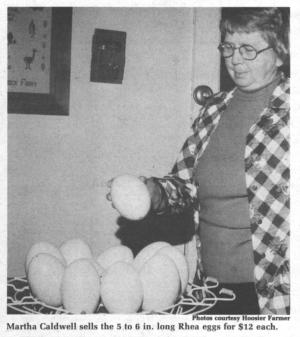1982 - Volume #6, Issue #5, Page #18
[ Sample Stories From This Issue | List of All Stories In This Issue | Print this story
| Read this issue]
Rare Bird's Big Eggs Selling Like Hotcakes
 |
The Caldwells, for the past seven years, have been raising a South American species of bird, the rhea, that lays eggs 5 to 6 in. long. These eggs, which far exceed turkey and goose eggs in size, are a valuable commodity for the art market.
Mrs. Caldwell sells the eggs for $12 each and has developed markets for them in Pennsylvania, New York, California, Colorado, Michigan and other states. They are especially popular on the West Coast.
The source of some 150 to 200 of these eggs per year is the rhea "flock" of one male and three female birds. Each female lays about 60 eggs between March and September. The newly laid egg is a buff color which lightens with age.
The rhea is a bird you'll usually find only in a zoo. It's a grey and white, non-flying, fast-running bird related to the ostrich.
The Caldwells got interested in these birds in 1974 when their daughter began egg decorating and was looking for bigger eggs. They bought a male and two females from a hobbyist and had to wait a while for the first eggs because the females don't start laying until 2 years old.
The rhea lives to be 18 to 20 years old and keeps laying every year. The Caldwells have the original male but have replaced some of the females.
"At first we tried to save some eggs and raise our own replacements, but we didn't have any luck," says Mrs. Caldwell. "Now when we need a new bird, we go back to the original seller who raises them in an incubator."
For the farm family that might like to raise rheas, a breeding pair 4 to 6 weeks old will cost at least $150. Beyond that cost, the expenses are minimal.
"Rheas need no housing," says Mrs. Caldwell. "In fact, they won't go inside in even the coldest weather. We don't provide any nesting place for them, as the male finds a depression in the grass for the nest. If the female lays an egg outside the nest, the male rolls it in. He also is the one who sits on the eggs and guards the nest.
Rheas like grass and leafy vegetables such as lettuce, and they are fed a mixture of shelled corn and rabbit pellets, in addition to what they graze. In the laying season they get a mixture of laying mash and dry dog food.
The Caldwells will gladly share their experience with egg buyers and persons interested in raising rheas.
For more information, contact: FARM SHOW Followup, Kenneth & Martha Caldwell, Rt. 1, Box 65, Milton, Ind. 47357 (ph 317 478-3913).

Click here to download page story appeared in.

Click here to read entire issue
To read the rest of this story, download this issue below or click here to register with your account number.




